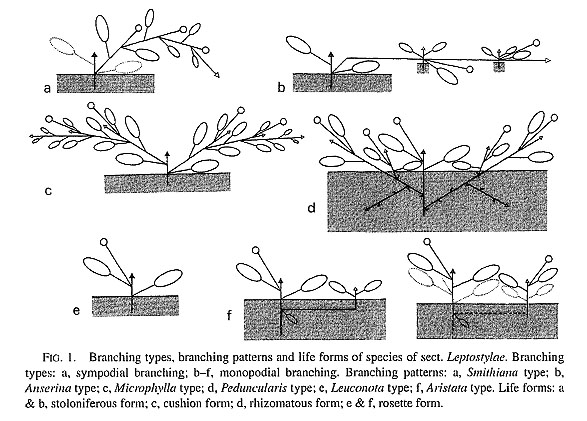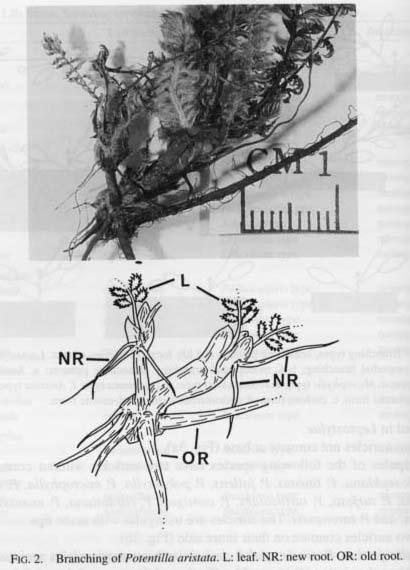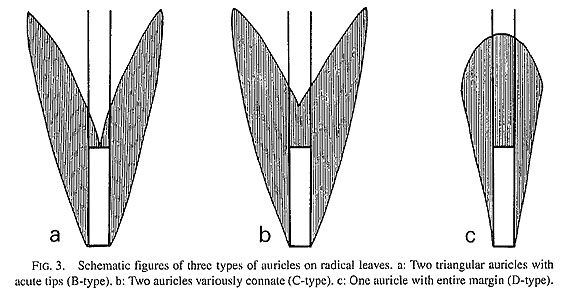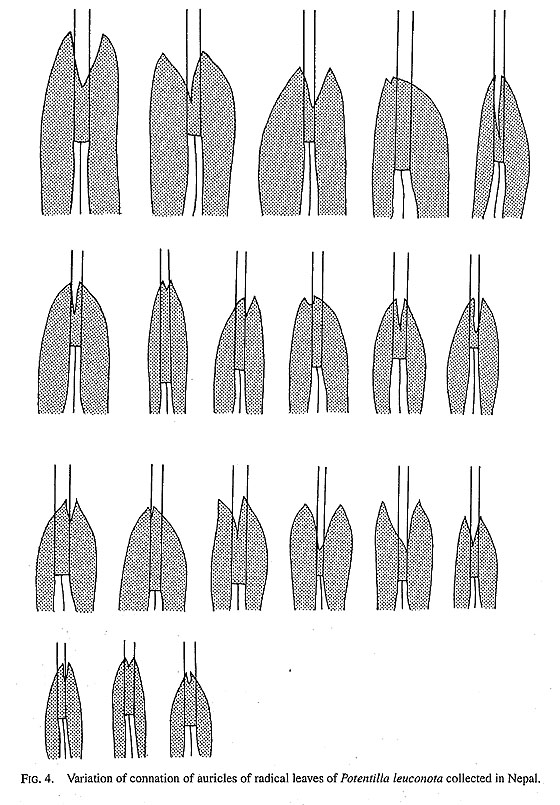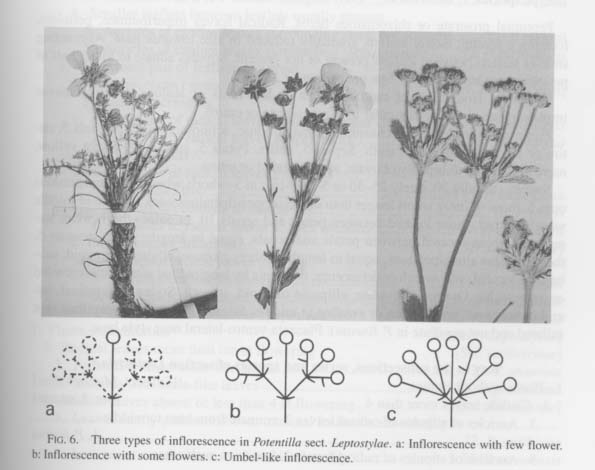A SYSTEMATIC REVISION OF POTENTILLA L. SECTION LEPTOSTYLAE (ROSACEAE) IN THE HIMALAYA AND ADJACENT REGIONS
| ( 1 / 4 ) |
|
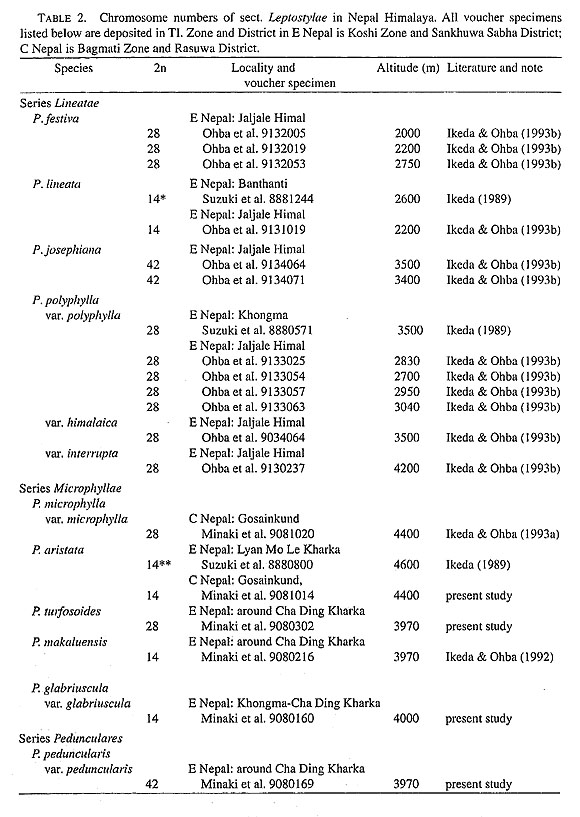 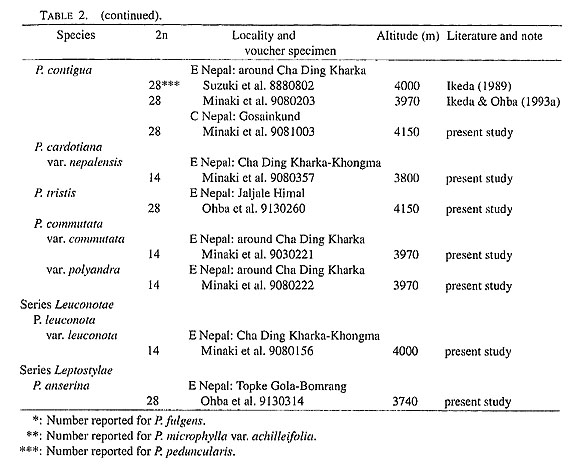 |
By assessing the basic chromosome number of Potentilla to be x=7, then 2n=14 is diploid, 2n=28 is tetraploid and 2n=42 is hexaploid. It is clear that a polyploid series exists in Leptostylae. Diploid and tetraploid species are found in series Microphyllae, and diploid, tetraploid, and hexaploid species occur in series Lineatae and Pedunculares.
No relationship between ploidy level and altitudinal distribution was found. This observation is similar to the situation in Saxifraga (Wakabayashi & Ohba 1989).
Systematic Treatment
Potentilla L., Sp. Pl. 495 (1753). Seringe in DC., Prodr. 2: 571 (1825). G. Don, Gen. Hist. 2: 549 (1838). Endlicher, Gen. Pl. 1242, n. 6363 (1840). Lehm., Rev. Potentilla. 1 (1856). Hook.f. in Benth. and Hook.f., Gen. Pl. 1: 620 (1865). Focke in Engl. and Prantl, Nat. Pfl.-fam. III, 3: 34 (1891). Wolf, Monogr. Potentilla 1 (1908). Rydberg in North Amer. Fl. 22: 293 (1908). Hutchinson, Gen. Fl. Pl. 1: 197 (1964). Lectotype species: P. reptans L. (Rydberg 1908).
Section Leptostylae (Th.Wolf) T.T. Yü et C.L. Li in Yü, Fl. Reipubl. Popul. Sin. 37: 263 (1985).
Potentilla section Gymnocarpae Th.Wolf subsection Leptostylae Th. Wolf, Monogr. Potentilla 52 (1908).
Type species: P. anserina L.
Perennial prostrate or rhizomatous herbs. Radical leaves imparipinnate, petiolate, forming a rosette; lateral leaflets gradually reduced in size towards base. Alternating smaller leaflets between leaflets present or not present. Stipules adnate to lower half of petioles; auricles of stipules free or connate.
Peduncles from axils of radical leaves or leaf axils of stolons. Cauline leaves imparipinnate. Stipules triangular to ovate, serrate or entire.
Flowers solitary or in a dichasium, hermaphroditic, actinomorphic. Episepals 5, entire or serrate, with 2 or 3 teeth. Sepals 5, entire. Petals 5, spreading, bright yellow, narrowly oblong to broadly obovate, apex rounded or retuse.
Stamens usually 20, rarely 25-30 or 5-10(-15); in 3-whorls when 20, alternipetalous ones 5, those of inner whorl longer than others; oppositipetalous ones 5, those of middle whorl shortest; those located between petals and sepals 10, in outer whorl; when stamens 10, these located between petals and sepals, equal in length; when stamens 5, these stamens alternipetalous, equal in length. Anthers globose, ellipsoid or ovoid, subbasal, 4 loculed, yellow before dehiscence, dehiscent by longitudinal slits. Pistils crowded on receptacles. Ovaries 1-ovulate, ellipsoid to ovoid, smooth. Styles subterminal, lateral or subbasal, not swollen or swollen at middle. Stigmas inflated and papillate (not inflated and not papillate in P. lineatd). Placenta ventro-lateral near style base.
Key to the subsections, series and species of section Leptostylae
 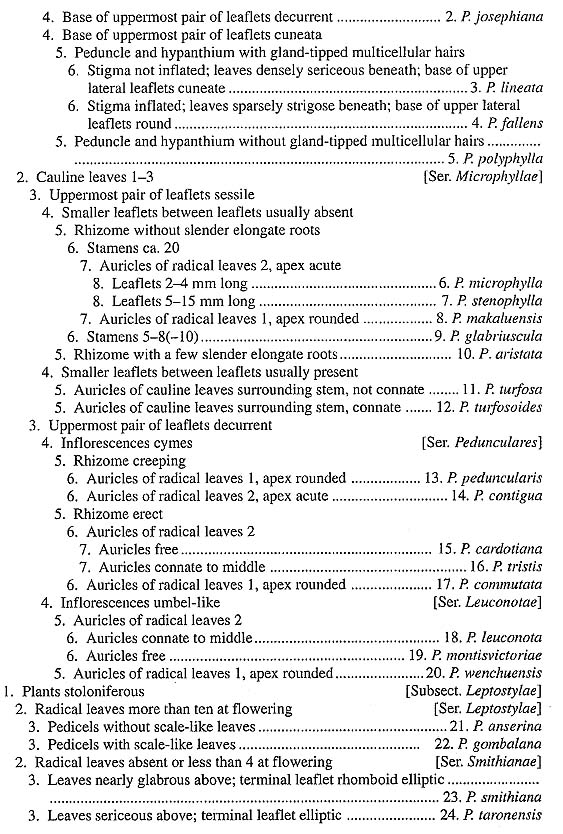 |
A. Subsection Microphyllae (T.T. Yü et C.L. Li) H. Ikeda et H. Ohba, stat, nov.
BASIONYM: Sen Microphyllae T.T. Yü et C.L. Li in Acta Phytotax. Sin. 18: 5 (1980); in Yü, Fl. Reipubl. Popul. Sin. 37: 271 (1985).
i. Series Lineatae H. Ikeda et H. Ohba, ser. nov.
Foliis cauliferis numero multis quam 4 ornatis.
Type species: Potentilla lineata Trev.
1. Potentilla festiva Soják in Candollea 43: 166 (1988). Miehe, Langtang Himal 445 (1990). Ikeda in Ohba and Akiyama, Alp. Fl. Jaljale Himal 35 (1992). Ikeda and Ohba in Bot. J. Linn. Soc. 112: 166 (1993).
2. Potentilla josephiana H. Ikeda et H. Ohba in Bot. J. Linn. Soc. 112: 168 (1993).
BASIONYM: P.fulgens Wall ex Hook. var. intermedia Hook.f., Fl. Brit. Ind. 2: 350 (1878). Wolf, Monogr. Potentilla 146 (1908).
SYNONYM: P. lineata Trev. var. intermedia (Hook.f.) Dixit et Panigrahi in Proc. 4th Ann. Conf. Orissa Bot. Soc. 25 (1979). Grierson and Lone, Fl. Bhutan 1: 571 (1987). Ikeda in Ohba and Akiyama, Alp. Fl. Jaljale Himal 36 (1992).
3. Potentilla lineata Trev., Ind. Sem. Vratislav. 1822 (1822). Reichenbach, Hort. Bot. Fasc. 1: 7, t. 8 (1824). Sprengel. Syst. 2: 534 (1825). Panigrahi and Dixit in J. Econ. Tax. Bot. 1: 131 (1980). Mabberly in Taxon 33: 443 (1984). Grierson and Long, Fl. Bhutan 1: 571 (1987), excl. var. intermedia. Ikeda in Ohba and Akiyama, Alp. Fl. Jaljale Himal 36 (1992). Ikeda and Ohba in Bot. J. Linn. Soc. 112: 169 (1993).
SYNONYMS: P. splendens Wall. ex D. Don, Prodr. Fl. Nepal. 230 (1825).
P.fulgens Wall. ex Hook. in Bot. Mag. 53: t. 2700 (1826). Lehm., Rev. Potentilla. 54 (1856). Hook. f., Fl. Brit. Ind. 2: 349 (1878), excl. var. intermedia. Franchet, Pl. Delavay. 3: 211 (1890). Duthie, Cat. Pl. Kumaon 56 (1906). Wolf, Monogr. Potentilla 145 (1908), excl. var. intermedia. Burkill in Bot. Surv. Ind. 4(4): 107 (1910). H. Léveillé, Cat. Pl. Yun-Nan 232 (1917). J. Krause in Repert. Spec. Nov. Regni Veg. Beih. 12: 408 (1922). Handel-Mazzetti, Symb. Sin. 7: 510 (1933); in Acta Hort. Gothob. 13: 304 (1939). Fletcher in Notes Roy. Bot. Gard. Edinb. 20: 210 (1950). Kitamura in Kihara, Fauna Fl. Nepal Himal. 152 (1955). Banerji in Rec. Bot. Surv. Ind. 19(2): 40 (1966). Murata in Hara, Fl. E. Himal. 123 (1966). Dept. Med. Pl. Nepal, Med. Pl. Nepal 70 (1970). Murata in Hara, Fl. E. Himal. 2: 53 (1971). Subramanyam in Rec. Bot. Surv. Ind. 20(2): 89 (1973). Malla et al. in Bull. Dept. Med. Pl. Nepal 7: 78 (1976). Ohashi in Hara and Williams, Enum. Fl. Pl. Nepal 2: 140 (1979). Wu et al., Index Fl. Yunnan. 1: 493 (1984). Yü and Li in Yü, Fl. Reipubl. Popul. Sin. 37: 261 (1985). Yü et al. in Wu, Fl. Xizang. 2: 247 (1985). Malla et al. in Bull. Dept. Med. Pl. Nepal 11: 284 (1986). Miehe, Langtang Himal 445 (1990). Ku in Wang et al., Vasc. Pl. Hengduan Mts. 1: 848 (1993).
P. siemersiana Lehm., [Ind. Sem. Hort. Bot. Hamb. 8 (1821), nom. nud.] Pugill. 1: 31 (1828). Bernardi in Candollea 18: 275 (1963). Lauener in Notes Roy. Bot. Gard. Edinb. 30: 260 (1970).
P. martini H.Lév. in Bull. Soc. Bot. France. 55: 57 (1908).
P. fulgens Wall. ex Hook. var. macrophylla Card., Lecornte, Not. Syst. 3: 232 (1914). H. Léveillé, Cat. Pl. Yun-Nan 232 (1917). Handel-Mazzetti in Acta Hort. Gothob. 13: 304 (1939). Wu et al., Index Fl. Yunnan. 1: 494 (1984).
P. siemersiana Lehm. var. acutiserrata T.T. Yü et C.L. Li in Acta Phytotax. Sin. 18: 7,t. 1,f.2(1980).
P. fulgens Wall. ex Hook. var. acutiserrata (T.T. Yü et C.L. Li) T.T. Yü et C.L. Li in Yü, Fl. Reipubl. Popul. Sin. 37: 263, t. 39, f. 3 & t. 4 (1985).
4. Potentilla fallens Card. in Lecomte, Not. Syst. 3: 232 (1914). H. Léveillé, Cat. Pl. Yun-Nan 232 (1917). Handel-Mazzetti, Symb. Sin. 7: 511 (1933). Fletcher in Notes Roy. Bot. Gard. Edinb. 20: 210 (1950). Wu et al., Index Fl. Yunnan. 1: 493 (1994). Yü and Li in Yü, Fl. Reipubl. Popul. Sin. 37: 261 (1985). Ikeda and Ohba in Bot. J. Linn. Soc. 112: 174 (1993). Ku in Wang et al., Vasc. Pl. Hengduan Mts. 1: 848 (1993).
SYNONYMS: P. rockiana Melch. in Notizb. Bot. Gart. Mus. Beri.-Dahlem 11: 795 (1933). Handel-Mazzetti in Acta Hort. Gothob. 13: 321 (1939).
P. peduncularis D.Don var. obscura auct. non Hook.f.; Diels in Notes Roy. Bot. Gard. Edinb. 7: 131 (1912).
5. Potentilla polyphylla Wall. [Cat. 28, n. 1026 (1829), nom. nud.] ex Lehm., Pugill. 3: 13 (1831); Rev. Potentilla. 53 (1856). Wolf, Monogr. Potentilla 143 (1908). Ohashi in Hara and Williams, Enum. Fl. Pl. Nepal 2: 140 (1979). Panigrahi and Dixit in J. Econ. Tax. Bot. 1: 132 (1980). Polunin and Stainton, Flow. Himal. 125 (1984). Yü and Li in Yü, Fl. Reipubl. Popul. Sin. 37: 260 (1985). Yü et al. in Wu, Fl. Xizang. 2: 647 (1985). Grierson and Long, Fl. Bhutan 1: 571 (1987). Miehe, Langtang Himal 445 (1990). Shah and Wilcock in Wildenowia 21: 199 (1991). Ikeda in Ohba and Akiyama, Alp. Fl. Jaljale Himal 36 (1992). Ikeda and Ohba in Bot. J. Linn. Soc. 112: 176 (1993). Ku in Wang et al., Vasc. Pl. Hengduan Mts. 1: 848 (1993).
var. polyphylla
SYNONYMS: P. sordida Klotzsch in Bot. Ergebn. Reise Waldemar. t. 9 (1862).
P. mooniana auct. non Wight; Hook.f., Fl. Brit. Ind. 2: 349 (1878), pro parte. Kitamura in Kihara, Fauna Fl. Nepal Himal. 152 (1955). Murata in Hara, Fl. E. Himal. 124 (1966). Dept. Med. Pl. Nepal, Fl. Phulchoki Godawari 33 (1969). Malla et al. in Bull. Dept. Med. Pl. Nepal 7: 79 (1976).
var. himalaica H. Ikeda et H. Ohba in Bot. J. Linn. Soc. 112: 179 (1993).
var. interrupta (T.T. Yü et C.L. Li) H. Ikeda et H. Ohba in Bot. J. Linn. Soc. 112: 179(1993).
BASIONYM: P. interrupta T.T. Yü et C.L. Li in Acta Phytotax. Sin. 18: 8 (1980). Wu et al, Index Fl. Yunnan. 1: 495 (1984). Yu and Li in Yü, Fl. Reipubl. Popul. Sin. 37: 267 (1985). Ikeda in Ohba and Akiyama, Alp. Fl. Jaljale Himal 35 (1992). Ku in Wang et al.. Vase. Pl. Hengduan Mts. 1: 849 (1993).
var. barbata Lehm., Rev. Potentilla. 54 (1856). Wolf, Monogr. Potentilla 145 (1908). Ikeda and Ohba in Bot. J. Linn. Soc. 112: 182 (1993).
SYNONYM: P. mooniana Wight, Icon, Pl. Ind, Orient. 1: t. 233 (1839). Lehm., Rev. Potentilla. 54 (1856). Hook. f., Fl. Brit. Ind. 2: 349 (1878), pro parte. Duthie, Cat. Pl. Kumaon 56 (1906).
A detailed taxonomic treatment of this series was published in Bot, J. Linn. Soc. 112: 159-186 (Ikeda and Ohba 1993b) under the name Potentilla lineata group.
Species of the P. lineata group have been included in sect. Closterostylae. Wolf (1908) included P. lineata (as P.fulgens), P. josephiana (as P. fulgens var. intermedia) and P. polyphylla in Closterostylae. Yü and Li (1985) included P. lineata (as P.fulgens), P. polyphylla and P. fallens in Closterostylae.
Section Closterostylae was characterized by the basal, spindle-shaped styles, and section Leptostylae by the lateral rod-shaped styles (Wolf 1908; Yü and Li 1980,1985). In spite of differences between Closterostylae and Leptostylae, Kalkman (1968) noted the similarity between P. polyphylla and the southeast Asian species of Leptostylae, and wrote: "I do not see sufficient reason to separate them so widely." Soják (1994b) presented a key to the species of Leptostylae (as sect. Pentaphylloides) and included species of the P. lineata group in sect. Leptostylae.
The position and shape of the styles are variable between species and these characters are not reliable for the circumscription of sects. Closterostylae and Leptostylae.
Section Leptostylae is characterized by the nature of the auricles of the stipules of the radical leaves and the mode of elongation of the main stem. Species of sect.
Leptostylae (including the P. lineata group) have the auricles of the stipules of the radical leaves located on the adaxial side of the petioles; in other species of sect. Closterostylae they are on the lateral side. In addition, species of sect. Leptostylae (including the P. lineata group) have the main stems always near the ground and aerial stems with terminal flowers elongate from the axils of rosulate leaves. The main stems elongate and terminate in flowers in other species of sect. Closterostylae.
Although Soják (1994a) regarded P. josephlana as identical with P. interrupta (=P. polyphylla var. interrupta), these two taxa can be distinguished by the nature of the uppermost pair of leaflets (decurrent at base in P. josephiana, sessile in P. polyphylla var. interrupta). The two species also have different chromosome numbers (2n=42 in P. josephiana and 2n=28 in P. polyphylla var. interrupta).
ii. Series Microphyllae
6. Potentilla microphylla D. Don, Prodr. Fl. Nepal. 231 (1825). Seringe in DC, Prodr. 2: 583 (1825). Lehm., Pugill. 3: 17 (1831), excl. δ latifolia; Rev. Potentilla. 30 (1856), excl. δ latiloba. Royle, Ill. Bot. Himal. 208, t. 41, f. 2 (1835). Hook. f., Fl. Brit. Ind. 2: 352 (1878), excl. vars. achilleifolia and commutata. Strachey, Cat. Pl. Kumaon 56 (1906), excl. var. commutata. Wolf, Monogr. Potentilla 681 (1908), excl. southeast Asian ones and vars. achilleifolia and latifolia. Marquand in J. Linn. Soc. Bot. 48: 175 (1929). Kitamura in Kihara, Fauna Fl. Nepal Himal. 152 (1955), excl. var. achilleifolia. Handel-Mazzetti in Acta Hort. Gothob. 13: 321 (1939). Bernardi in Candollea 18: 274 (1963), excl. var. achilleifolia. Malla et al. in Bull. Dept. Med. Pl. Nepal 7: 78 (1976). Ohashi in Hara and Williams, Enum. Flow. Pl. Nepal 2: 140 (1979), excl. vars. achilleifolia and commutata. Polunin and Stainton, Flow. Himal. 126 (1984), pro parte. Wu et al., Index Fl. Yunnan. 1: 496 (1984), excl. var. multijuga, pro parte. Yü and Li in Yü, Fl. Reipubl. Popul. Sin. 37: 271, t. 41, f. 11 (1985), excl, var. multijuga. Yü et al. in Wu, Fl. Xizang. 2: 649, t. 200, f. 10 (1985), excl. var. multijuga. Grierson and Long, Fl. Bhutan 1: 572 (1987), excl. vars. achilleifolia, latifolia, and latiloba, pro parte. Soják in Candollea 43: t. 1, f. 1-3; t. 2, f. 1 (1988). Miehe, Langtang Himal 445, t. D2. 89 (1990). Ikeda in Ohba and Akiyama, Alp. Fl. Jaljale Himal 36 (1992). Ku in Wang et al., Vase. Pl. Hengduan Mts. 1: 850 (1993), pro parte. Sojak in Bot. Jahrb. Syst.116:31(1994).
Type: Nepal; Gosainthan (Wallich 1010, BM-holotype, not seen).
Radical leaves oblanceolate, 0.5-6.0 cm long, 4-10 mm wide, lateral leaflets 2-10 pairs, without smaller leaflets; petiole 0.5-4.0 cm long; base of uppermost pair of leaflets cuneate. Leaflets strigose or hirsute beneath; terminal leaflet sessile or subsessile, oblong to narrowly obovate, 2.0-4.0 mm long, 1.5-2.5 mm wide, serrate, with 3-9 teeth. Auricles of stipules free.
Peduncles 1-10 cm long. Cauline leaves simple, entire or tri-lobed. Auricles of stipules entire or rarely tri-lobed.
Inflorescence 1 or 2(-3) flowered; pedicel 2-12 mm long. Flowers 1.0-1.5 cm across; hypanthium 5-12 mm across. Episepals lanceolate to oblong, 1.5-3.5 mm long, 0.5- 1.0 mm wide, entire or deeply divided into two lobes, apex acute or obtuse, sparsely strigose on both surfaces. Sepals elliptic to ovate, 3.5-4.5 mm Ions, 1.5-3.0 mm wide,entire, apex acute or obtuse, nearly glabrous above, lower surface and margin strigose. Petals oblong to elliptic, apex rounded, 3.0-8.0 mm long, 2.5-6.0 mm wide.
Stamens 1.2-2.5 mm long; anthers globose to ellipsoid, 0.4-0.7 mm long, 0.4-0.7 mm wide. Ovaries ellipsoid, 0.5-0.8 mm long, 0.4-0.5 mm wide; styles 0.5-1.3 mm long, slender; stigmas slightly inflated.
Potentilla microphylla is a small prostrate herb and bears 1 or 2 yellow flowers. Potentilla glabriuscula, P. aristata, and P. commutata and small plants of P. stenophylla and P. turfosa were often determined as P. microphylla. On the other hand, it appears that P. luteopilosa and P. tapetodes, which were described as distinct species, should be included as infraspecific taxa within P. microphylla.

6a. var. microphylla [Figs. 8 & 31; Pls. 10-13]
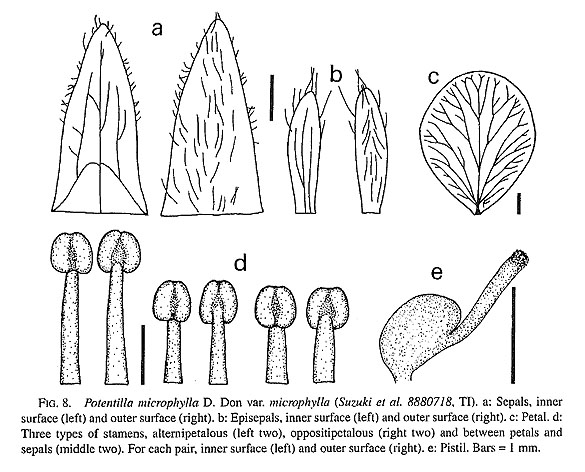
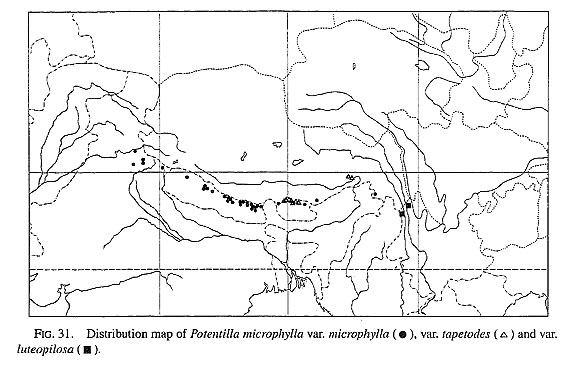
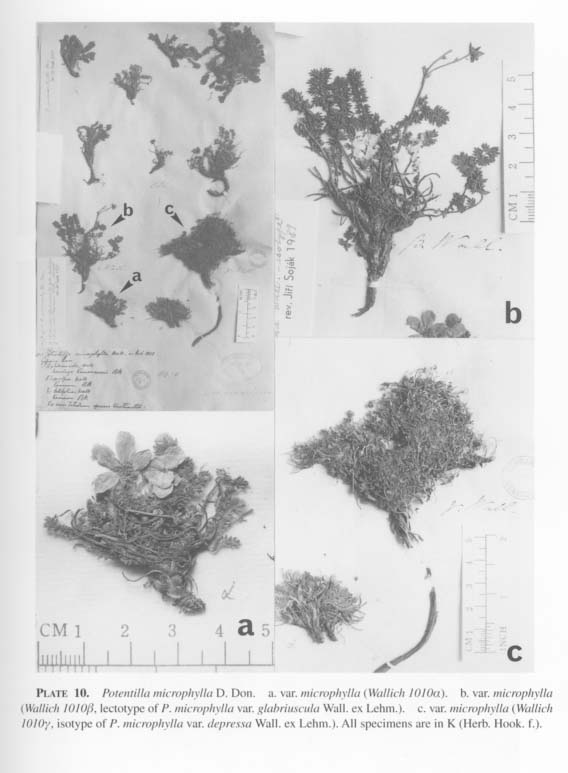
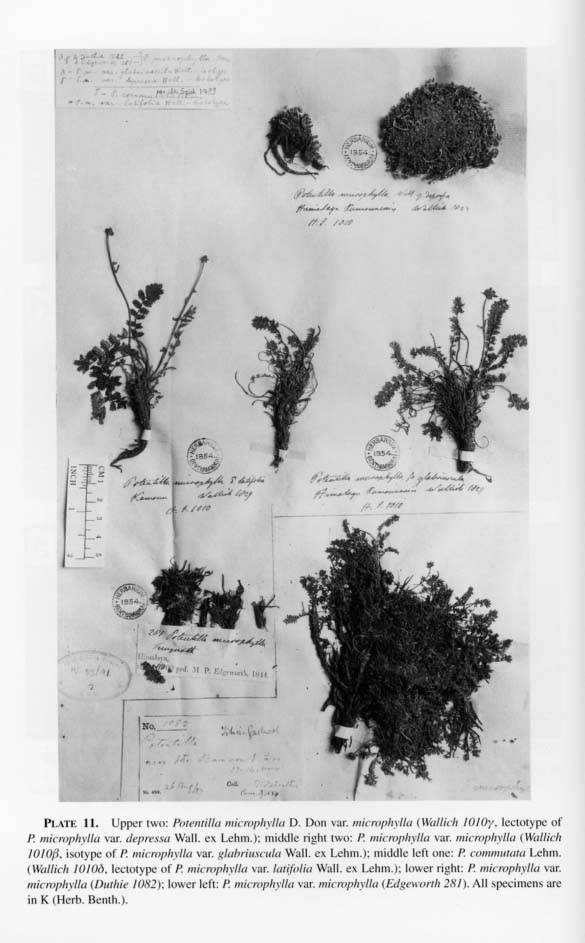

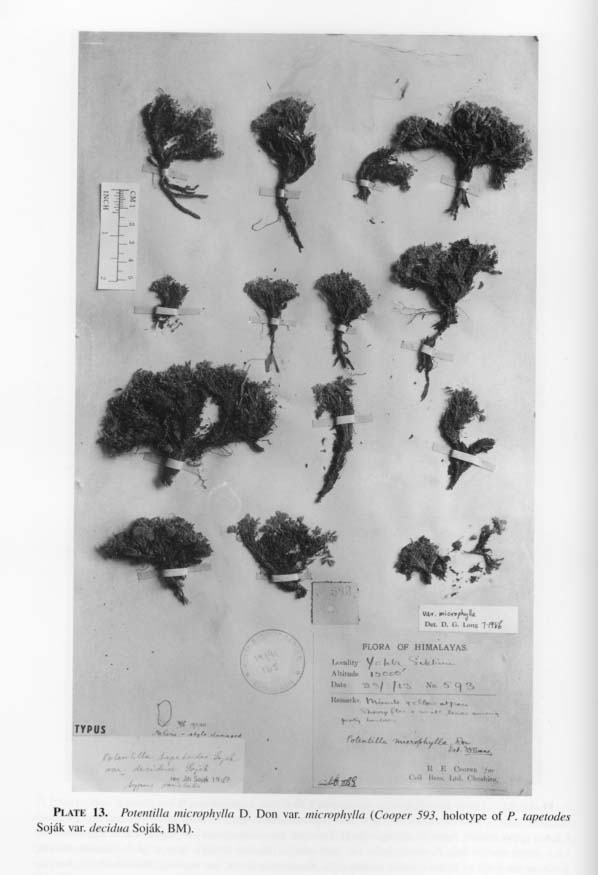
SYNONYMS: P. microphylla D.Don β (var.) glabriuscula Wall. [Cat. 28, n. 1010β (1829), nom. nud.] ex Lehm., Pugill. 3: 19 (1831); Rev. Potentilla. 30 (1856). Strachey, Cat. Pl. Kumaon 56 (1906). Wolf, Monogr. Potentilla 682 (1908). Handel-Mazzetti, Symb. Sin. 7: 519: (1933), pro parte. Wu et al., Index Fl. Yunnan. 1: 497 (1984), pro parte. Yü and Li in Yü, Fl, Reipubl. Popul. Sin. 37: 274 (1985), pro parte. Yü et al. in Wu, Fl. Xizang. 2: 650 (1985), pro parte.
Types: Nepal; Gosainthan (Wallich 1010β, K-lectotype, designated by Soják in 1989, and isolectotype, BM, E, L, NY-isolectotypes).
P. microphylla D.Don γ (var.) depressa Wall. [Cat. 28, n. 1010γ (1829), nom. nud.] ex Lehm., Pugill. 3: 19 (1831); Rev. Potentilla. 30 (1856). Wolf, Monogr. Potentilla 682(1908).
Types: Nepal; Gosainthan (Wallich 1010γ, K-lectotype, designated by Soják in 1989, and isolectotype, A, BM, E-isolectotypes).
P.microphylla D.Don var. latiloba auct. non Wall. ex Lehm.; Hook. f., Fl. Brit. Ind. 2: 353 (1878). Strachey, Cat. Pl. Kumaon 56 (1906). Wolf, Monogr. Potentilla 682 (1908).
P.microphylla D.Don var. achilleifolia auct. non Hook. f.; Wu et al., Index Fl. Yunnan. 1: 497 (1984). Yü and Li in Yü, Fl. Reipubl. Popul. Sin. 37: 272 (1985). Yü et al. in Wu, Fl. Xizang. 2: 650 (1985).
P. tapetodes Soják var. decidua Soják in Bot. Jahrb. Syst. 116: 34 (1994).
Radical leaves 3-6 cm long, 4-8 mm wide, lateral leaflets 7-9 pairs; petiole 0.5- 1.5 cm long; terminal leaflet 2.0-3.5 mm long, 1.5-2.5 mm wide, with 5-9 teeth.
Peduncles 1-4 cm long; pedicel 0.5-4.0 cm long. Flowers 1.0-1.5 cm across; hypanthium 5-8 mm across. Episepals 2.0-2.5 mm long, 0.5-1.0 mm wide. Sepals 3.5-4.0 mm long, 1.5-2.0 mm wide. Petals 6-8 mm long, 5-6 mm wide.
Stamens 2.0-2.5 mm long; anthers 0.5-0.7 mm long, 0.5-0.7 mm wide. Ovaries 0.6-0.8 mm long, 0.4-0.5 mm wide; styles 1.0-1.3 mm long.
Chromosome number 2n=28.
Distr. NW India, Nepal, Sikkim, Bhutan, and China (Xizang).
Variety microphylla grows in alpine grasslands, on rocky slopes and on glacier soils and forms cushions. The cushion habit is found also in other species, such as Arenaria, Androsace, Saussurea, etc. and is thought to be an adaptation to severe alpine environments.
The length and number of leaflets vary according to the habitat. Plants in grasslands have long leaves with many leaflets, while plants in glacier soils have short leaves with few leaflets. Wallich's collection no. 1010β bears fairly long leaves with many leaflets and no. 1010γ bears short leaves with few leaflets.
6b. var. luteopilosa (T.T. Yü et C.L. Li) H. Ikeda et H. Ohba, stat. et comb. nov. [Fig. 31; Pl. 14]
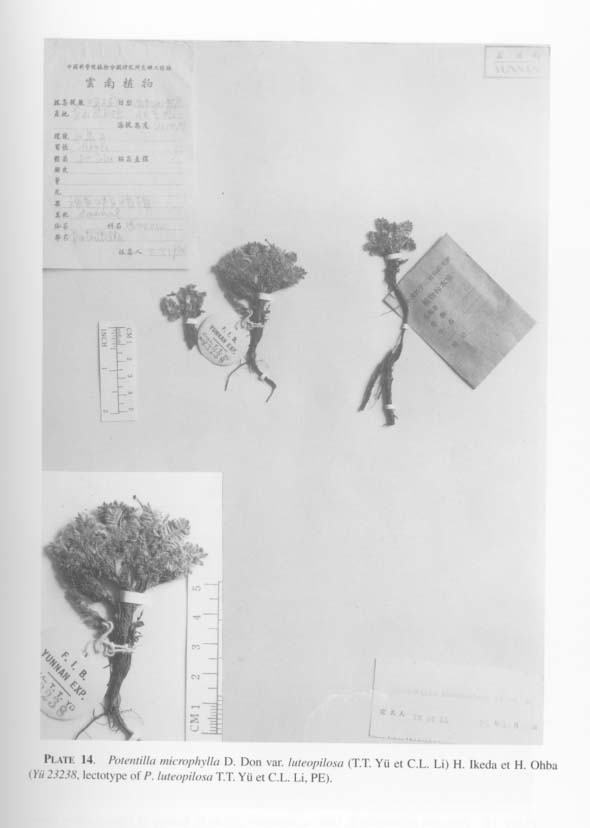
BASIONYM: Potentilla luteopilosa T.T. Yü et C.L. Li in Acta Phytotax. Sin. 18: 9, t. 5, f. 2 (1980). Wu et al., Index. Fl. Yunnan. 1: 496 (1984). Yü and Li in Yü, Fl. Reipubl. Popul. Sin. 37: 274, t. 41, f. 8-10 (1985). Ku in Wang et al., Vasc. Pl. Hengduan Mts. 1: 850 (1993). Soj á k in Bot.Jahrb.Syst.116: 35 (1994).
Types: China; Yunnan, Gongshan, 4100 m (T.T. Yü 23238, 4 Oct. 1938, PE-lecto-type, designated here, A, E-isolectotypes). Deqin, alt. 3800-3900 m (Feng 6738, 18 Aug. 1940,PE-syntype).
Radical leaves 1.0-1.8 cm long, 6-10 mm wide, lateral leaflets 7-10 pairs; petiole 2-4 mm long; terminal leaflet 2-4 mm long, 1.5-2.5 mm wide, with 7-9 teeth.
Peduncles 3-10 mm long. Pedicel 7-12 mm long. Flowers 1-1.5 cm across; hypanthium 6-12 mm across. Episepals 2-3.5 mm long, 0.7-1.0 mm wide. Sepals 3.5-4.5 mm long, 2-3 mm wide.
Distr. China (Yunnan, Sichuan, and Xizang).
Variety luteopilosa was first described as a species distinct from P. microphylla based on differences in incision and hairiness of the leaflets (Yü and Li 1980), The leaflets of var. luteopilosa are incised about half way through the lamina and the apex of the leaflets is obtuse. Variety microphylla has the leaflets deeply incised nearly to the main nerve and the apex of the leaflets is acute.
6c. var. tapetodes (Soják) H. Ikeda et H. Ohba, stat. et comb. nov. [Figs. 9 & 31; Pl. 15]
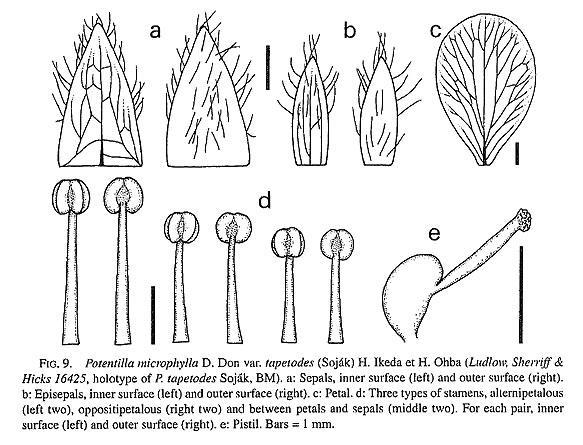
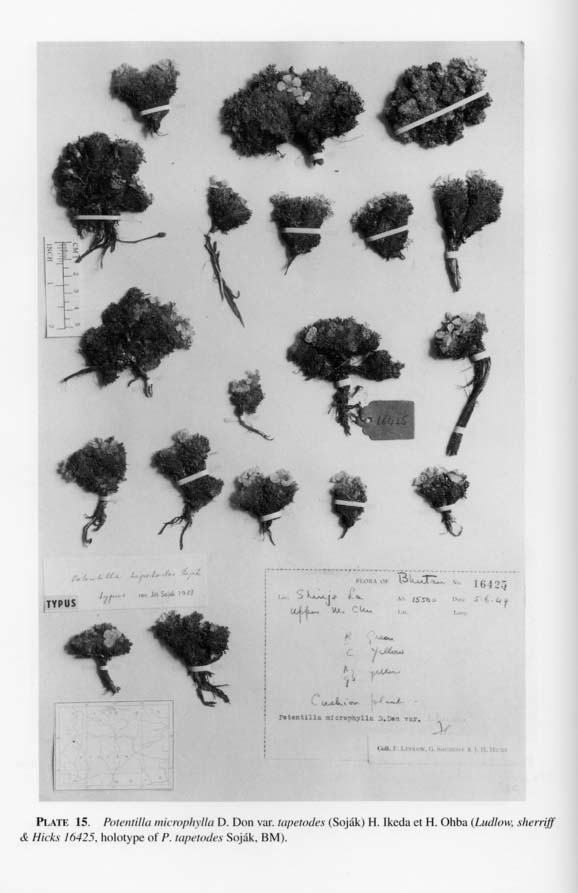
BASIONYM: P. tapetodes Soják in  . Nár. Muz. Odd.
. Nár. Muz. Odd.  . 152: 160 (1983); in Candollea 43: 161, t. l, f. 4-6; 162, t. 2, f. 3 (1988); in Bot. Jahrb. Syst. 116: 32 (1994), excl. var. decidua.
. 152: 160 (1983); in Candollea 43: 161, t. l, f. 4-6; 162, t. 2, f. 3 (1988); in Bot. Jahrb. Syst. 116: 32 (1994), excl. var. decidua.
Type: Bhutan; Shinje La, upper Mo Chu, 15500 ft. (Ludlow, Sherriff & Hicks 16425, 5 June 1949, BM-holotype).
SYNONYM: P. microphylla D. Don var. caespitosa T.T. Yü et C.L. Li in Yü, Fl. Reipubl. Popul. Sin. 37: 274, t. 41, f. 12 (1985). Yü et al. in Wu, Fl. Xizang. 2: 650, t. 200, f. 9 (1985), nom. illeg. (without Latin diagnosis and no indication of type specimen).
Radical leaves 0.5-1.0 cm long, 4-7 mm wide, lateral leaflets 2 or 3(-5) pairs; petiole 2-3 mm long; terminal leaflet 2-4 mm long, 1.5-2.0 mm wide, with 3-5 teeth.
Peduncles 3-5 mm long; pedicel 3-5 mm long. Flowers 1.0-1.5 cm across; hypanthium 5-7 mm across. Episepals 1.5-2.0 mm long, 0.7-1.0 mm wide. Sepals 2.0-2.5 mm long, 1.5-2.0 mm wide. Petals 3.0-4.0 mm long, 2.6-3.3 mm wide.
Stamens 1.2-1.4 mm long; anthers 0.4-0.5 mm long, 0.4-0.5 mm wide. Ovaries 0.5-0.6 mm long, 0.4-0.5 mm wide; styles 0.5-0.7 mm long.
Distr. Sikkim, Bhutan, and China (SE Xizang).
Variety tapetodes has smaller leaves (0.5-1.0 cm long) and fewer leaflets (2 or 3, rarely 5 pairs) than var. microphylla. The stems of var. tapetodes are surrounded by many old leaves that form a tower-like structure. The large cushions of var. tapetodes are formed by the clustering of the stems.
Although P. microphylla var. caespitosa was described in Fl. Reipubl. Popul. Sin.
37: 274 (Yü and Li 1985), the diagnosis was written in Chinese and no type specimen was indicated. I examined a specimen in PE indicated by Yü and Li as the type of var. caespitosa (Qinghai-Xizang Exped. 5698, a duplicate specimen deposited in KUN) and the specimen is identical with var. tapetodes.
7. Potentilla stenophylla (Franch.) Diels in Notes Roy. Bot. Gard. Edinb. 5: 271 (1912). H. Léveillé in Cat. Pl. Yun-Nan 233 (1917). Handel-Mazzetti, Symb. Sin. 7: 518 (1933). Melchior and Stroh in Notizb. Bot. Gart. Mus. Berl.-Dahlem 11: 799 (1933). Fletcher in Notes Roy. Bot. Gard. Edinb. 20: 215 (1950), pro parte. Lauener in Notes Roy. Bot. Gard. Edinb. 30: 261 (1970). Wu et al., Index Fl. Yunnan. 1: 498 (1984), pro parte. Yü and Li in Yü, Fl. Reipubl. Popul. Sin. 37: 270, t. 40, f. 6 (1985), pro parte. Soják in Candollea 43: t. 4, f. 5 (1988). Ku in Wang et al., Vasc. Pl. Hengduan Mts. 1: 849 (1993), Soják in Bot. Jahrb. Syst. 116: 47 (1994).
BASIONYM: P. peduncularis D. Don var. stenophylla Franch., Pl. Delavay. 3: 214 (1890). Wolf, Monogr. Potentilla 678 (1908).
Type: China; Yunnan, Tsang-shan, Tali [Cang Shan, Dali] (Delavay s.n., P-holotype, not seen).
Radical leaves oblanceolate, 2.5-23 cm long, 0.8-3.5 cm wide, lateral leaflets 5-25 pairs, without smaller leaflets; petiole 1-4 cm long; base of uppermost pair of leaflets cuneate. Leaflets appressed hairy or glabrous beneath except with tuft hairs at tips in var. cristata; terminal leaflet sessile or subsessile, oblong to elliptic, 6-15 mm long, 4-8 mm wide, serrate, with 3-15 teeth. Auricles of stipules free.
Peduncles 3-25 cm long. Cauline leaves simple, serrate, with 3-5 teeth in var. cristata or with 1-5 pairs of leaflets. Auricles of stipules entire or serrate, with 3-5 teeth.
Pedicel 1.5-4.0 cm long. Flowers 1.0-2.0 cm across; hypanthium 6-10 mm across. Episepals lanceolate to elliptic, 1.5-4.0 mm long, 0.7-3.0 mm wide, entire or with 2 or 3 teeth, apex acute or obtuse, sparsely strigose on both surfaces. Sepals elliptic to ovate, 2.0-6.0 mm long, 1.5-4.5 mm wide, entire, apex acute or obtuse, puberulent toward apex above, lower surface and margin strigose. Petals oblong to elliptic, apex rounded, 3.0-7.0 mm long, 2.6-5.5 mm wide.
Stamens 1.2-2.0 mm long; anthers globose to ellipsoid, 0.4-1.0 mm long, 0.4-0,9 mm wide. Ovaries ellipsoid, 0.5-0.8 mm long, 0.4-0.6 mm wide; styles 0.5-1.3 mm long, slender; stigmas slightly inflated.
Potentilla stenophylla was first described as a variety of P. peduncularis (Franchet 1890). Potentilla stenophylla differs from P. peduncularis by having stipules with two free auricles on the radical leaves; P. peduncularis has one membranaceous auricle.

7a. var. stenophylla [Figs. 10 & 32; Pls. 16 & 17]
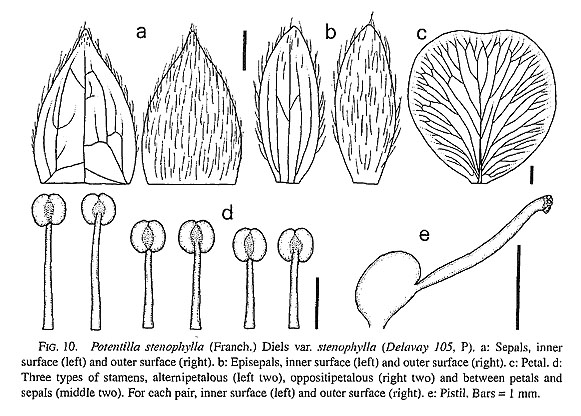
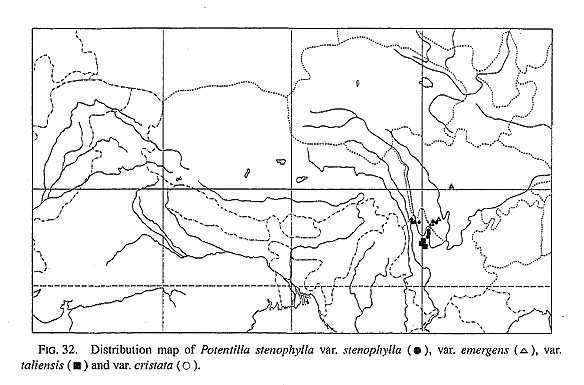
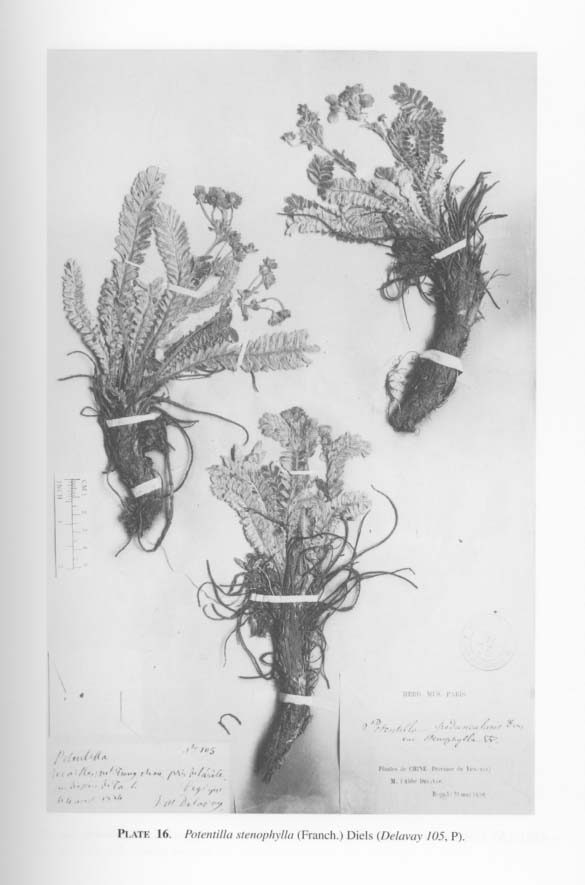

SYNONYMS: P. millefolia non Rydb. (1896), H. Lév. in Bull. Acad. Geog. Bot. 24: 281 (1914); as "P. millefolium". Cat. Pl, Yun-Nan 232 (1917).
Types: China; Yunnan, lo-chan, 3400 m (Maire s.n., E-holotype and isotype, Pisotype).
P. stenophylla (Franch.) Diels var. millefolia (H. Lév.) Soják in Bot. Jahrb. Syst. 116:48 (1994), as "var. millefolium", nom. invalid.
Radical leaves 7-13 cm long, 1.2-2.0 cm wide, lateral leaflets 15-25 pairs; petiole 1.0-1.5 cm long. Terminal leaflet 6-10 mm long, 4-6 mm wide, dentate or 5-lobed on upper part of leaflets.
Peduncles 7-10 cm long; pedicel 1.5-2.5 cm long. Flowers 1.2-1.5 cm across; hypanthium 6-10 mm across. Episepals 3-5 mm long, 1.5-3.0 mm wide. Sepals 4-6 mm long, 2.5-4.5 mm wide. Petals 5-7 mm long, 4.0-4.5 mm wide.
Stamens 1.5-2.0 mm long; anthers 0.6-1.0 mm long, 0.4-0.9 mm wide. Ovaries 0.6-0.8 mm long, 0.4-0.6 mm wide; styles 0.9-1.3 mm long.
Distr. China (Yunnan, Sichuan, and Xizang).
Variety stenophylla is characterized by having leaflets with 3(-5) teeth. Soják (1994a), however, distinguished var. millefolia from var. stenophylla by the number of serra tions (var. millefolia has three while var. stenophylla has two). The number of serrations is variable and it is difficult to distinguish the two varieties.
7b. var. cristata (Fletcher) H. Ikeda et H. Ohba, stat, et comb. nov. [Fig. 32; Pl. 18]
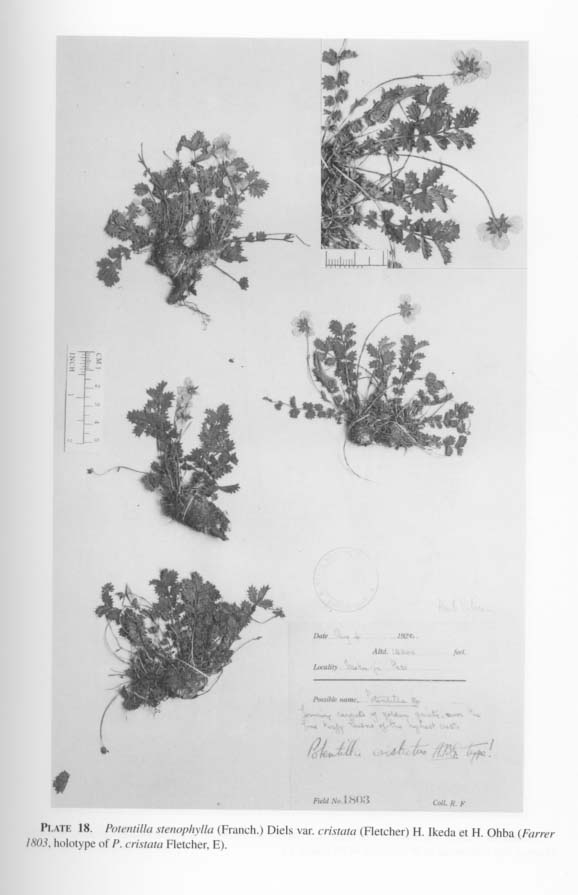
BASIONYM: P. cristata Fletcher in Notes Roy. Bot. Gard. Edinb. 20: 218 (1950).
Type: Upper Burma; Moku-ji Pass, 12200 ft. (Farrer 1803, 4 Aug. 1920, E-holo-type).
Radical leaves 3.5-5.5 cm long, 1.0-1.5 cm wide, lateral leaflets 5-8 pairs; petiole 0.5-1.0 cm long; terminal leaflet 1.0-1.2 cm long, 5-7 mm wide, with 11-13 teeth.
Peduncles 3-4 cm long; pedicel 1.5-2.0 cm long. Flowers 1.2-1.5 cm across; hypanthium 7-8 mm across. Episepals 2-4 mm long, ca. 1 mm wide, with 2-3 teeth. Sepals 2.0-2.5 mm long, 1.5-2.0 mm wide. Petals 3-4 mm long, 2.6-3.3 mm wide.
Stamens 1.2-1.4 mm long; anthers 0.4-0.5 mm long, 0.4-0.5 mm wide. Ovaries 0.5-0.6 mm long, 0.4-0.5 mm wide; styles 0.5-0.7 mm long.
Distr. N Myanmar and China (Yunnan).
Variety cristata has broader glabrous leaflets with tufts of hairs at the tips of the serrations.
7c. var. taliensis (W.W. Smith) H. Ikeda et H. Ohba, stat. et comb. nov. [Figs. 11 & 32; Pl. 19]

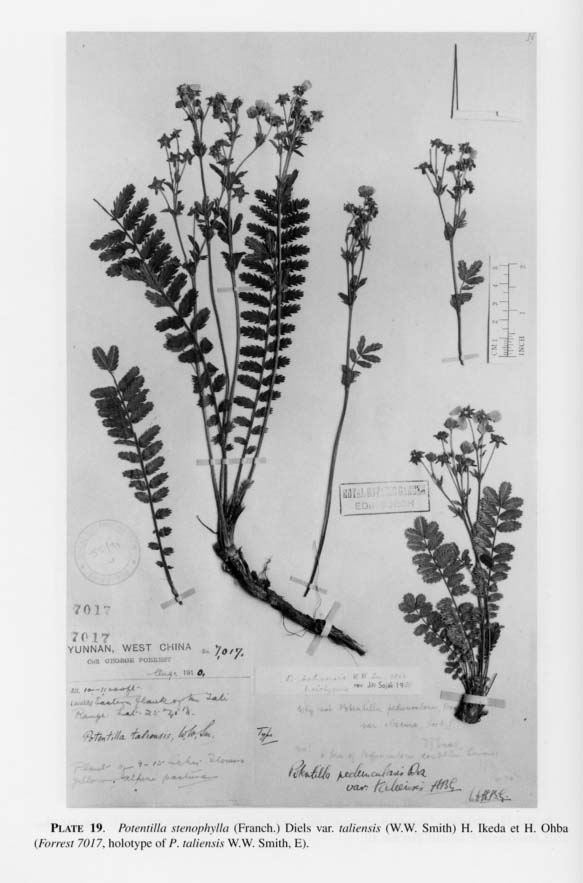
BASIONYM: P. taliensis W.W. Smith in Notes Roy. Bot. Gard. Edinb. 7: 199 (1914). YÜ and Li in YÜ, Fl. Reipubl. Popul. Sin. 37: 270 (1985). Soj á k in Candollea 43: t. 3, f. 11 (1988).
Types: China; Yunnan, Tali Range, 25°40'N, 10000-11000 ft., (G. Forrest 7017, Aug. 1910, E-holotype, K-isotype).
Radical leaves 4-23 cm long, 1.2-3.5 cm wide, lateral leaflets 5-15 pairs; petiole 1-4 cm long; terminal leaflet (0.6-)0.8-1.5 cm long, 4-8 mm wide, with 6-15 teeth.
Peduncles 7-18 cm long; pedicel 1-3 cm long. Flowers 1.2-2.0 cm across; hypanthium 7-10 mm across. Episepals 1.5-2.0 mm long, 0.7-1.0 mm wide. Sepals 2.0-2.5 mm long, 1.5-2.0 mm wide. Petals 3-4 mm long, 2.6-3.3 mm wide.
Stamens 1.2-1.4 mm long; anthers 0.4-0.5 mm long, 0.4-0.5 mm wide. Ovaries 0.5-0.6 mm long, 0.4-0.5 mm wide; styles 0.5-0.7 mm long.
Distr. China (Yunnan).
Variety taliensis has leaflets hairy on both surfaces and with 6-15 serrations, Variety taliensis is restricted to the area around Dali, Yunnan, China.
7d. var. emergens Card. in Lecomte, Not. Syst. 3: 241 (1914). Melchior and Stroh in Notizb. Bot. Gart. Mus. Berl.-Dahlem 11: 800 (1933). [Figs. 12 & 32; Pls. 20-22]
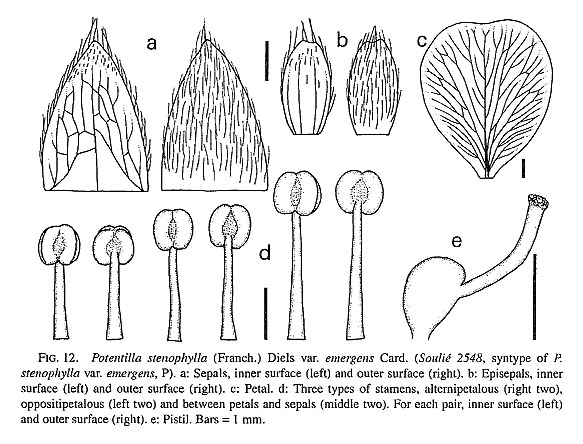
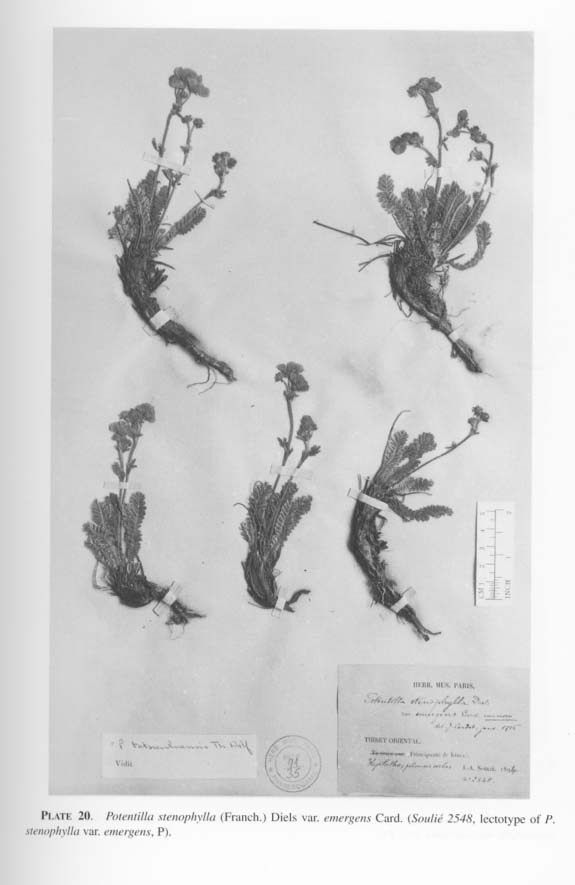

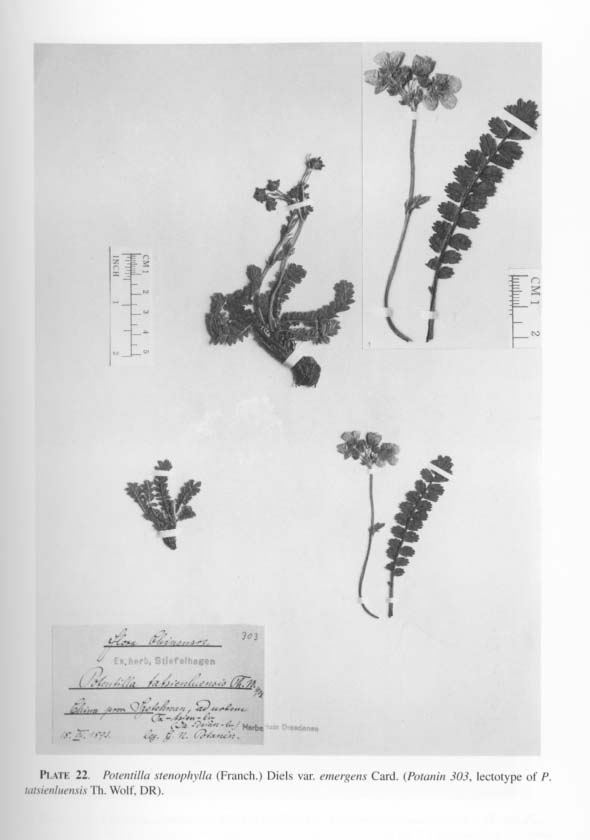
Types: China; Szechuan, Kiala, Kajilatho (Souli é 2548 in 1894, P-lectotype, desig
nated here). Szechuan, Tatsienlu [Kangding] (Mussot 110 in 1897, P-syntype). Szechuan, Kiala, Tongolo (Souli é 97, July 1891, P-syntype). Szechuan, Kiala, Tatsienlu (Souli é 893, 10 July 1893, P-syntype). W China, 10000-13000 ft. (Wilson 3461, July 1903, Psyntype).
SYNONYMS: P. microphylla auct. non D. Don; Hook. f., Fl. Brit. Ind. 2: 352 (1878), pro minor parte. Wu et al.. Index Fl. Yunnan. 1: 496 (1984), pro parte.
P. tatsienluensis Th.Wolf, Monogr. Potentilla 680 (1908). Handel-Mazzetti in Acta Hort. Gothob. 13: 323 (1939). Fletcher in Notes Roy. Bot. Gard. Edinb. 20: 216 (1950). Wu et al., Index Fl. Yunnan. 1: 499 (1984). Yü and Li in Yü, Fl. Reipubl. Popul. Sin. 37: 271, t. 40, f. 5 (1985). Yü et al. in Wu, Pl. Xizang. 2: 649 (1985). Soják in Candollea 43: t. 3, f. 5 (1988). Ku in Wang et al., Vasc. Pl. Hengduan Mts. 1: 849 (1993). Soják in Bot. Jahrb. Syst. 116: 51 (1994).
Types: China; Sichuan, Tatsienlu [Kangding] (Potanin s.n., July 1893, DR-holotype and isotype).
P. stenophylla (Franch.) Diels var. exaltata Card. in Lecomte, Not. Syst. 3: 241 (1914).
Types: China; Szechuan, Kiala, Tongolo (Souli é 659 in 1893, P-lectotype, designated here). Szechuan, Kiala, Tongolo (Souli é 88, July 1891, P-syntype). Szechuan, Kiala, Tatsienlu (Souli é 539 in 1893, P-syntype).
? P. stenophylla (Franch.) Diels var. compacta J.Krause in Repert. Spec. Nov. Regni Veg. Beih. 12:410(1922).
Types: Ost-Tibet [Sichuan] Tatsienlu-Dawo, Aufstieg zum Passe Gila (Limpricht 1671 in 1914, WRSL-lectotype, designated by Soják in 1994, WU-isolectotype, not seen).
Radical leaves 2.5-13 cm long, 0.8-1.5 cm wide, lateral leaflets 8-15 pairs; petiole 1.0-2.0 cm long; terminal leaflet 6-10 mm long, 4-6 mm wide, with 4-7 teeth.
Peduncles 4-25 cm long; pedicel 1.5-4.0 cm long. Flowers 1.0-1.8 cm across; hypanthium 6-10 mm across. Episepals 1.5-2.0 mm long, 0.7-1.0 mm wide. Sepals 2.0-2.5 mm long, 1.5-2.0 mm wide. Petals 3-4 mm long, 2.6-3.3 mm wide.
Stamens 1.2-1.4 mm long; anthers 0.4-0.5 mm long, 0.4-0.5 mm wide. Ovaries 0.5-0.6 mm long, 0.4-0.5 mm wide; styles 0.5-0.7 mm long.
Distr. Sikkim and China (Sichuan and Xizang).
Variety emergens is characterized by leaflets with 5-7 teeth. Variety exaltata has sparse, blunt leaflets but it should be included in var. emergens. Potentilla tatsienluensis is identical with var. emergens.

